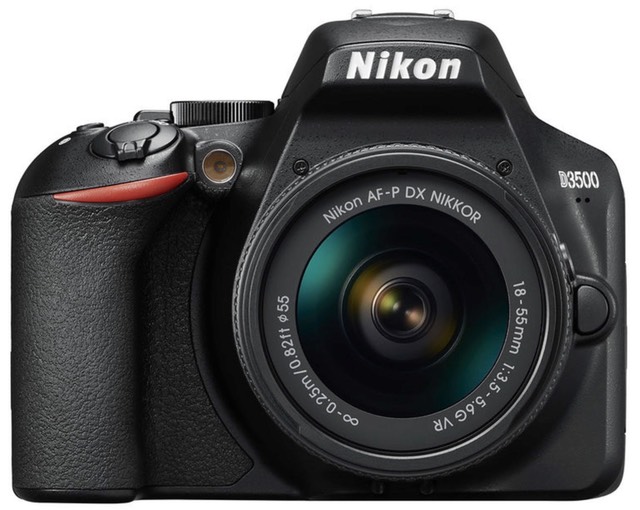
Thom's quick takes:
- Low price, but high image quality
- Solid video capability, though lots of wobble on fast motion
- Mostly plastic
- Features missing (bracketing, DOF Preview, mirror up, WiFi)
- Must use AF-S or AF-P lenses!
- Guide mode doesn't do a lot of useful guiding
Specifications:
- Introduced: 8/30/2018
- Replacement Estimate: 2019/2020 (may be mirrorless)
- Current Firmware: C1.0
- Sensor Size: 23.5x15.6mm, DX ~1.5x crop
- Sensor Pixels: 24.2mp
- Sensor Maker: Nikon NC81369R?
- Sensor Technology: CMOS, Bayer, no AA filter, microlens
- Max Image Size: 6000x4000
- Other Image Sizes: 4496x3000, 2992x2000
- Video: 1080P/60/50/30/25/24 stereo sound (internal mic mono), 720P 60/50 (stored in .MOV with H.264 compression and linear PCM audio), 20 minute maximum length at highest quality, 30 at normal
- ADC Bit Depth: 12 bit, EXPEED4
- Raw File Formats: 12 bit Compressed NEF
- Other File Formats: JPEG
- JPEG/TIFF Rendering: 16-bit rendering, 8-bit output
- Auto Rotation: Yes
- Color Spaces: sRGB, Adobe RGB
- Storage: SD, SDHC, or SDXC, UHS-I and Eye-Fi
- Max Write Speed: ?MB/sec
- Max Buffer: ? JPEG Fine (? @ any other JPEG setting), ? RAW (? with JPEG)
- Connectivity: USB 2.0 HIGH, Bluetooth 4.1
- TV Support: NTSC and PAL, HDMI
- Lens Support: Type AF-P, E, and G lenses only (other AF don't focus)
- Autofocus Module: CAM1000 (11 sensor, 1 crosshatch), -1 to 19EV sensitivity
- Shutter Lag: ?ms
- Autofocus Modes: Single, Dynamic, Auto Area, 3D Tracking
- Autofocus Assist: Yes (white lamp)
- Metering: 420-pixel Color matrix, centerweight, spot
- Exposure Modes: PSAM + 7 Scene + GUIDE+special effects
- Exposure Compensation: +/- 5 stops, 1/3 stop
- Exposure Bracketing: None
- ISO: 100-25600, AUTO
- White Balance: Auto, custom, 6 predefined with fine tuning
- Image Settings: Picture Controls, Sharpening, Contrast, Saturation, Brightness, Hue
- Color LCD: 3", 921,000 dots 170 degree viewing
- Image Review: Histogram, Highlights
- Continuous Shooting Speed: 5 fps
- Shutter Speeds: 30s to 1/4000, bulb. 100k rated
- Mirror Lockup: No
- Viewfinder: Pentamirror, 95%, 0.85x magnification, 18mm eyepoint, -1.7 to +.5 diopters
- Optional Viewfinder Accessories: DR-6 right angle, -5 to +3 diopter corrections, DG-2 magnifier
- Optional Focus Screens: None
- Menus: Playback, Shooting, Custom Settings, Setup, Retouch, MyMenu
- Flash Sync Speed: 1/200
- Flash Type: I-TTL, M
- Internal Flash: Yes GN 22ft 7m (ISO 100) (slightly higher in manual mode)
- PC Sync: No (via optional AS-15)
- Flash Compensation: -3 to +1EV
- Flash Options: Red Eye, Slow Sync, Rear Sync, Flash Lock
- DOF Preview: No (alternative: Live View)
- Optional Remotes: SnapBridge, WR-R10/WR-T10
- Colors: Black
- Size: 4.9 x 3.9 x 2.8 " (124x97x69.5mm)
- Weight: 14.7 ounces (415g) w/battery and card
- Battery: EN-EL14a (1500 shots CIPA)
- Optional AC Adapter: EP-5a + EH-5a/b
- Other significant: no top LCD (rear color LCD used instead), PictBridge, in camera small picture option, layered images, in-camera editing and trimming, in camera B&W and color filtration, in-camera D-Lighting, in-camera perspective control, color outline, soft filters, FUNC button, can mount non-AI lenses without damage, RAW to JPEG in camera conversion, eye detection sensor, intelligent guide, GPS support via smartphone, quiet shooting mode, easy panorama mode
- Included Software: View NX-i, Capture NX-D
- Price at Introduction: US$499 (with 18-55mm AF-P kit lens)
